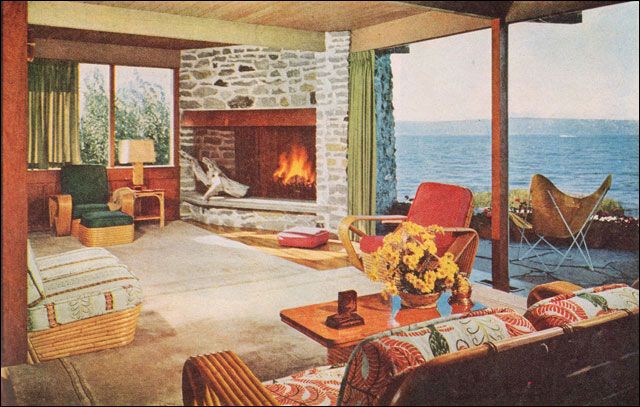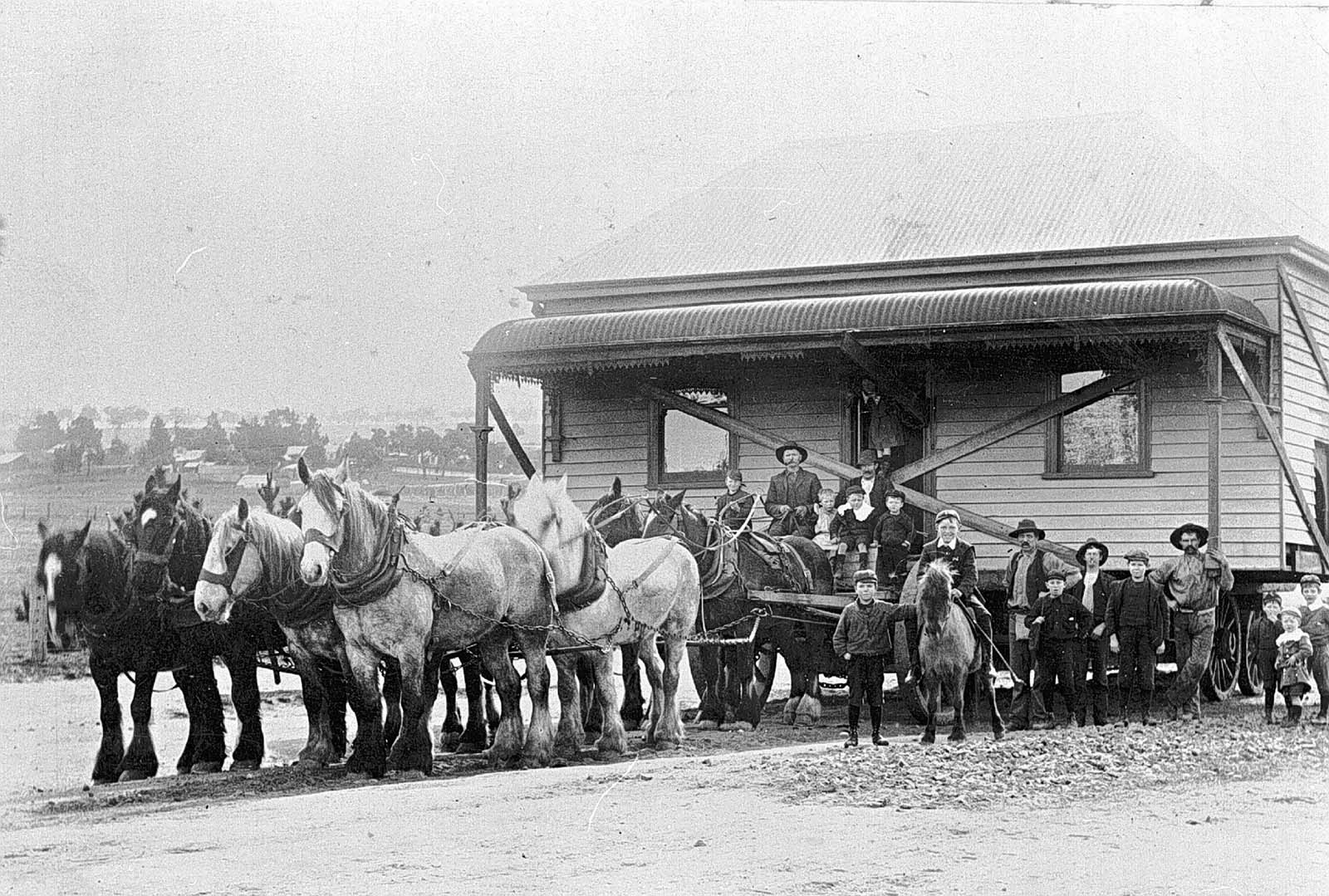The 1950s were a decade filled with exuberance, radiating a positive outlook from the United States triumphant post-war recovery. The emphasis of a 1950s household was on comfort and leisure, with the decade being a prosperous time for most middle class families. More and more families were flocking to the suburbs, abandoning their city slicker lifestyles for a cozy home in a neighborhood and a big backyard for Fido. And because there was more time allocated for recreation and relaxation, interior design and decor became vibrant and fun.
In modern households, the future was near, with dynamic designs influenced by space exploration, science, and new technologies. These clean designs with Scandinavian influence took on a persona of their own, shaping into what we now know as Mid-Century Modern design. Mid-Century decor introduced innovative furniture and room composition, while maintaining a unique air of futurism combined with the classic All-American appeal.
Pastel colors and patterned dishware made for cozy kitchens, while colorful walls and furniture in living rooms made for the perfect place to settle down and watch the tube. 1950s home decor is a now traditional style that maintains its popularity in a modern market with new materials and combinations.
Furniture of the 1950s varied, ranging from traditional upholstered furniture to space age, futuristic shaped pieces. Vinyl dining chairs and chrome-legged tables with Formica tops were considered fashionable additions to kitchens and dining rooms. Laminated plywood furniture with clean lines dominated living rooms, and home bars became an important staple of the living space now that an emphasis was placed on entertaining. Outdoor furniture came hand-in-hand with more leisure time, with a new necessity placed on outdoor furniture and picnic gear.
![]()
|
| 1950 Armstrong Living Room – Coral, dark green, gray, and maroon were a few of the favorite colors that popped up regularly during the early 1950s. This green, coral, and buff scheme has the linoleum floor, bamboo furniture, and barkcloth upholstery and drapes that we associate with the mid century. |
![]()
|
| 1951 Coral & Gray Living Room – This room, published in American Home, focused on incorporating antiques with modern furnishings. The color scheme of black, white, gray, and coral is strong and surprisingly lively. We are particularly smitten with the lamps. |
![]() |
| 1953 Armstrong Living Room – This living room was described as a “mother-in-law” apartment. The color scheme of gray-finished wood cabinetry, olive green, turquoise, and shell pink is perfect 1950s traditional style. We think Mom would be right at home. |
![]() |
| 1953 Armstrong Living Room With Cork Floor – This living room was an ad for Armstrong cork, but we like the modern, mid-century aesthetic with the raised hearth and painted brick fireplace. Unlike some Armstrong ads where the flooring was not the best feature of the room, we really like the cork. It's attractive, warm underfoot, and a great insulator and sound absorber. |
![]() |
| 1953 Modern Bungalow Living Room – This living room and dining room remodel is unique for its color, modern furnishings, and the respectful treatment of existing built-ins. Too often mid-century interior designers seemed to feel that taking out all reference to the past was necessary. This room incorporates new and old together successfully. |
![]() |
| 1953 Living Room With Reclaimed Brick Fireplace – This modern fireplace serves as both a structural element, focal point, and divider between the kitchen and living room with the dining ell off to the left. The squared brick and iron post construction is typical of many mid-century homes. |
![]() |
| 1953 Living Room by Edward Wormley – This super modern midcentury living room was designed for a Koylon ad for the foam cushions. The Japanese aesthetic with spare lines is warmed by the cork flooring and upholstered furniture. Natural materials abound in the lacquered cart, leather ottoman, and the shoji screen window covering. |
![]() |
| 1953 Modern Living Room – Mid-century modern means George Nakashima, Alvar Aalto, and the Eames, but is actually much less common than we’d like. This room with its vaulted ceiling, stone fireplace, and clean design is handsome, comfortable, and functional. |
![]() |
| 1953 Sun Porch – Our litmus test for good design is how relevant it remains 50 years later. This room might be described as a sun room, Florida room, or screened porch, but the mid century style here could easily be reproduced today by ferreting out a few good pieces of wicker and iron furniture, an appropriate retro upholstery fabric, accessories, and sisal rug. |
![]() |
| 1953 Stone Fireplace Living Room – This room was featured in an article in Better Homes & Gardens. The bamboo furniture, large expanses of glass, and cozy fireplace would be appealing in any decade. |
![]() |
| 1954 Armstrong Atomic Living - Dining Room – This kitchen, dining, and family room is close to our concept of the great room. It has lots of open space, bold color, and easy functioning areas that are comfortable, attractive, and informal. It’s clean, timeless design makes it an inspirational image today. |
![]() |
| 1954 Heywood Wakefield Dining & Living – Heywood Wakefield, ever meeting the tastes of its buyers, ran several furniture lines concurrently including this modern set with the buffet serving as a room divider. Other lines were considerably more traditional like the Early American, which was arguably more popular than the modern during the 1950s. |
![]() |
| 1954 Modern Living Room – This is a wonderful comfortable mid-century room plan that would be easy to live with. The essential modern character is defined by the room with great clerestory windows and a massive brick fireplace. The white background and bright colors are classic retro design. |
![]() |
| 1957 Modern Living Room – Like many mid-century rooms, this living room - family room lends itself to 21st century living with ease. The only essential detail that would need to be found is the distinctive hanging light, which was extremely popular during the 1950s. Lay your hands on that puppy and you're good to go. If course, it would help to have a mid-century modern or ranch style home with clerestory windows, another common feature. |
![]() |
| 1957 Lavender Living Room – Published in Better Homes & Gardens, this room illustrated an article on using color for decoration. We like the stained Eames chair, colorful plaids for screen and bench, and the use of several lavender-based neutrals. It’s not everyday you get to enjoy fuschia. |
![]() |
| 1957 Armstrong Mid Century Living Room – Armstrong was a flooring leader during the 20th century. It's advertising was consistently on message and generally slightly ahead of the pack ... at least where the middle class was concerned. The company wasn't tied to any particular style, instead opting for a range of looks in any given year. This living room represents the bold, contemporary look that communicated a break from the past ... something the new generation of homeowners eagerly sought. |
![]() |
| 1957 Mid Century Living Room – The casual character of this room makes those of us who love the clean lines of mid-century modern furnishings wish we could lay our hands on that Bertoia chair or enjoy the raised hearth and sunburst clock. The gold, teal, and white scheme has a bit of punch with judicious use of black and red for extra color. |
![]() |
| 1957 Nairon Living Room – Ornate, organic shapes are a foil for the flooring that is the primary feature of this room. This opulence is evidence of a fresh wave of economic prosperity and optimism that marked the late 1950s. It had been 30 years since the last time gold gilt appeared in middle-class home decorating ads. |
![]() |
| 1957 Japan-Inspired Armstrong Living Room – Japanese-style furnishings and bold blue, white, and red color combine with mid century modern design elements to create a harmonious retro space. |
![]() |
| 1957 Armstrong Modern Living Room – Lavender, pink, red, and black combine in this mid-century room design by Armstrong to create a modern living room with flexibility. The couch and bench cushions, drapes and artwork are shown in bluees and white as an alternate summer scheme. |
![]() |
| 1957 Armstrong Living Room – This small family room, or TV room, was also designed to function as a guest room. Multifunction rooms could be drafted as offices, dens, and were often designated as another bedroom when needed. Built-ins, a favorite means of adding storage and functionality, minimize the need for furniture allowing a reasonable degree of comfort in a fairly small space. |
![]()
|
| 1958 Scandinavian Modern Living Room – Though Scandinavian design appears earlier in upper end and architectural publications, it doesn’t enter the mainstream until the late 1950s. The streamlined forms, modern furniture, organic shapes, and color stories change dramatically from 1950 to 1959. |

























